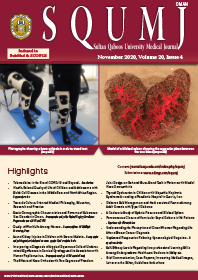Main Article Content
Abstract
Objectives: This study aimed to review the experience with percutaneous closure of ventricular septal defects (VSDs) at the National Heart Center (NHC) in Muscat, Oman. Methods: This retrospective study was conducted from November 2008 to December 2017. Patients’ electronic medical records were reviewed to identify their clinical, imaging and interventional data before and after the procedure and on the last followup. Results: A total of 116 patients, the majority of which were female (58%), underwent 118 percutaneous procedures for VSD closure at a median age of 3.54 years (range: 0.25–33 years) and a median weight of 12 kg (range: 3.5–78 kg). The mean diameter of the VSDs as determined by transoesophageal echocardiogram was 5.6 ± 1.9 mm (n = 105). The commonest type of VSD was perimembranous (n = 75, 63.5%). Devices were successfully placed during 111 (94.1%) procedures in 109 (94.0%) patients, with the commonest device being a Amplatzer™ duct occluder I (St. Jude Medical, Little Canada, Minnesota, USA; n = 39, 35.1%). There was no mortality. Early major cardiac complications occurred in six patients (5.5%) with device embolisation being the commonest (n = 4, 3.7%). The median follow-up period was 19 months (range: 1–84 months) in 89 (81.7%) of the patients. One patient (0.9%) required a permanent pacemaker for a complete heart block. Conclusion: This study has demonstrated a good rate of VSD closure with low morbidity and no mortality using the percutaneous approach with different devices. Long-term follow-up is needed to specifically evaluate the function of adjacent structures and the long-term effects on conduction systems.
Keywords: Ventricular Septal Defect; Percutaneous Coronary Intervention; Amplatzer Occluder Device; Vascular Closure Device; Heart Block; Oman.
Article Details

This work is licensed under a Creative Commons Attribution-NoDerivatives 4.0 International License.
